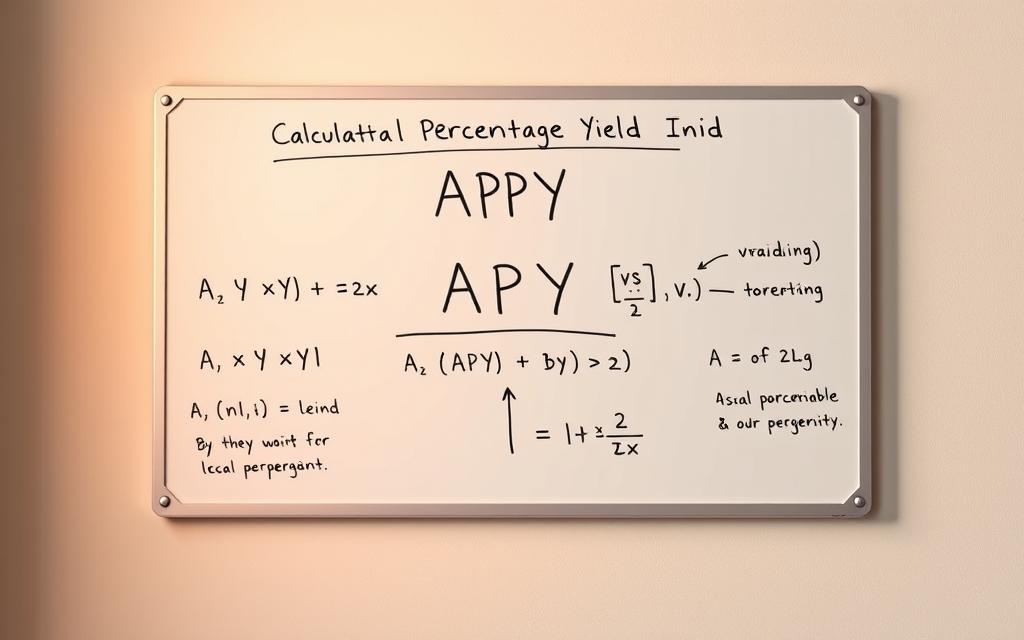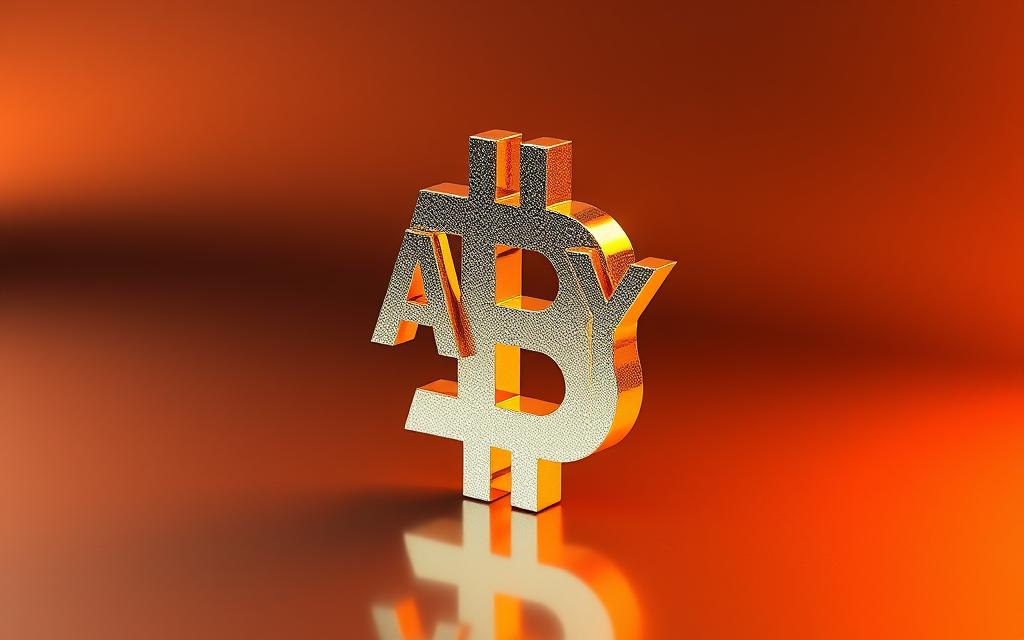Table of Contents
Earning passive income through crypto assets has become a game-changer for modern investors. Unlike traditional savings accounts offering less than 1% returns, digital currencies provide significantly higher opportunities.
The annual percentage yield metric helps measure compounded earnings over time. With over $28B in Ethereum staked via platforms like Lido, this concept demonstrates mainstream adoption.
DeFi platforms leverage this system to deliver 5-20%+ returns, even during market corrections. For example, staking ETH currently yields around 5%, while Atomic Wallet offers 7% on SOL holdings.
This guide explores how savvy investors utilize these mechanisms. We’ll break down staking, yield farming, and key differences between simple vs. compounded returns.
What Is APY in Crypto? Understanding the Basics
Crypto investors often overlook the power of compound interest when evaluating returns. Unlike traditional finance, digital assets leverage compounding to generate exponential growth. This section breaks down how annual percentage yield (APY) works and why it’s critical for maximizing earnings.
Definition of Annual Percentage Yield (APY)
APY measures total yearly returns, including compounded earnings. For example, $1,000 at 10% APY grows to $1,100 after a year. The formula (1 + APR/n)^n − 1 accounts for how often interest is added (daily, monthly, etc.).
How APY Differs from Simple Interest
Simple interest calculates earnings only on the principal. A 10% rate on $1,000 yields $100 yearly. With APY, daily compounding boosts this to $104.70—a 4.7% difference. Crypto’s frequent compounding cycles make this gap even wider.
Why APY Matters in Cryptocurrency
High inflation in crypto demands returns that outpace asset depreciation. Bitcoin’s volatile APY history shows the risks of chasing unsustainable rates. Projects like Cardano offer stable 4% staking rewards, while newer altcoins may promise—but fail to deliver—triple-digit yields.
Proof-of-stake blockchains rely on APY to incentivize validators. Investors must weigh compounding frequency against platform risks to avoid losses.
APY vs. APR: Key Differences Explained
Investors frequently confuse these two metrics, leading to miscalculated returns. While both measure earnings, annual percentage rate (APR) and annual percentage yield (APY) serve fundamentally different purposes in traditional finance and the crypto market.
APR: The Simple Interest Rate
APR reflects the basic cost of borrowing or earning without compounding. For example, a 10% simple interest rate on a $1,000 loan yields $100 annually. Regulatory rules mandate APR disclosures for transparency, especially in credit cards where 12% APR equals ~12.68% APY with monthly compounding.
APY: The Power of Compound Interest
APY includes compounded earnings, making it critical for investments. That same $1,000 at 10% APY grows to $1,104.70 with daily compounding—$4.70 more than APR. DeFi platforms like Aave display both rates to highlight how frequency impacts return investment.
| Metric | APR | APY |
|---|---|---|
| Compounding | No | Yes |
| Best For | Loans | Investments |
| $1k at 10% | $1,100 | $1,104.70 |
When to Use APY vs. APR in Crypto
Use APY for staking or yield farming to project earnings accurately. APR suits borrowing costs, like calculating fees on crypto loans. Watch for “APY washing”—unrealistic rates from risky DeFi projects. Always verify compounding frequency and platform audits.
“APR shows the cost of money; APY reveals its growth potential.”
Here’s a quick checklist to evaluate claims:
- Compare rates across reputable platforms (e.g., Aave vs. Compound).
- Check if rates account for token depreciation.
- Confirm compounding intervals (daily > monthly).
How APY Is Calculated in Crypto
Calculating returns accurately separates successful investors from those guessing outcomes. The annual percentage yield (APY) formula transforms raw rates into actionable insights. Here’s how to decode it for crypto assets.

The APY Formula and Compounding Frequency
The standard formula APY = (1 + r/n)^n – 1 includes:
- r: Annual interest rate (e.g., 5% = 0.05)
- n: Compounding periods per year (daily=365, monthly=12)
For ETH staking at 5% APY compounded daily, a 10 ETH stake grows to 10.51 ETH in a year. Monthly compounding yields 10.47 ETH—highlighting how frequency impacts earnings.
Examples of APY Calculations
Tools like Atomic Wallet’s built-in calculator simplify projections. Inputs include:
| Variable | Daily Compounding | Monthly Compounding |
|---|---|---|
| Principal | $1,000 | $1,000 |
| APY | 7% | 7% |
| Year 1 Value | $1,072.50 | $1,071.00 |
Factors That Influence APY Rates
Four critical elements determine yield sustainability:
- Network inflation: Cosmos’ 7-10% issuance affects staking rewards.
- Total value locked (TVL): Higher TVL (e.g., Curve Finance) often lowers APY due to diluted rewards.
- Validator performance: Slashing penalties reduce effective yields.
- Market demand: Borrowing surges on Aave temporarily boost lending APYs.
“Chasing triple-digit APYs often leads to ‘vampire mining’—short-term pumps followed by collapses.”
Tax authorities treat compounded earnings as income. Track each reinvestment to avoid reporting errors. Always verify platform audits before committing funds.
APY in Crypto Staking: How It Works
Liquid staking solutions revolutionized how traders earn without locking assets. Platforms like Lido pool $28B in ETH, offering flexibility alongside competitive yields. This section explores staking mechanics, top-performing coins, and how to pick reliable validators.
Staking Rewards and APY
Staking generates passive income by validating transactions. Rewards depend on network inflation and total value locked (TVL). For example, Ethereum’s Shanghai upgrade stabilized APY at 5%, while Solana offers 7% via Atomic Wallet.
Compounding boosts earnings significantly. Daily rewards on a 10 ETH stake at 5% APY grow to 10.51 ETH yearly. Compare this to simple interest, which would yield only 10.50 ETH.
Popular Cryptocurrencies with High APY
Not all assets deliver equal returns. Here’s how top coins compare:
| Asset | APY | Unbonding Period |
|---|---|---|
| Ethereum (ETH) | 5% | None (Lido) |
| Solana (SOL) | 7% | Instant |
| Cardano (ADA) | 4% | 21 days |
Note: Rates fluctuate with network demand. Always check real-time data before committing funds.
How to Choose a Staking Platform
Prioritize security and transparency. Follow this checklist:
- Validator performance: Aim for 99%+ uptime to avoid slashing penalties.
- Fees: Some platforms charge 10–15% of rewards.
- Custody: Non-custodial options (e.g., Ledger) reduce exchange risks.
“Liquid staking democratizes access to yields but requires due diligence on smart contract audits.”
For beginners, Atomic Wallet’s one-click SOL staking simplifies the process. Advanced users might prefer running independent nodes for higher control.
APY in Yield Farming and DeFi
Decentralized finance reshapes how investors generate earnings through automated protocols. Unlike traditional banking, yield farming leverages liquidity pools to deliver dynamic returns. These systems use smart contracts to distribute rewards based on supply and demand.

How Yield Farming Utilizes APY
Liquidity providers deposit assets into pools, receiving LP tokens as proof of stake. Trading fees and token emissions determine potential returns, often displayed as variable APY. For example, Uniswap’s ETH/USDC pool currently offers 12% APY from 0.3% trading fees.
Compounding multiplies earnings when rewards are reinvested. Daily compounding at 10% APY turns $1,000 into $1,105 in a year. Without compounding, the same rate yields just $1,100.
Comparing APY Across DeFi Platforms
Rates vary significantly between protocols. Here’s how top platforms compare:
| Platform | Average APY | Key Feature |
|---|---|---|
| Aave | 3-8% | Variable rates |
| Compound | 2-7% | Algorithmic adjustments |
| Yearn Finance | 5-15% | Auto-compounding vaults |
Note: Rates fluctuate with crypto market conditions. Always verify real-time data before investing.
Risks of Chasing High APY in DeFi
Triple-digit yields often signal unsustainable tokenomics or Ponzi schemes. Key red flags include:
- Impermanent loss: Price volatility reduces LP positions. Use APY calculators to model scenarios.
- Unaudited smart contracts: Over $2B was lost to hacks in 2022.
- Token depreciation: High APY may not offset falling asset values.
“Mercenary capital chases inflated yields but rarely stays long enough to realize them.”
For safer strategies, consider diversified staking across established platforms. Prioritize protocols with doxxed teams and insurance funds.
Risks and Considerations of APY in Crypto
High returns often come with hidden challenges in the digital asset space. While crypto assets offer attractive yields, understanding potential pitfalls separates informed investors from those chasing unsustainable rates.

Market Volatility and APY Fluctuations
Cryptocurrency prices can swing dramatically within hours. This market volatility directly impacts yields, as seen in Terra’s collapse. Anchor Protocol’s 19.5% APY on UST seemed stable until the ecosystem imploded, wiping out $40B in value.
Real-world examples show how quickly conditions change:
- Solana staking APY dropped from 8% to 3% during the FTX crisis
- Ethereum liquid staking yields fluctuated 40% post-Merge
- Cosmos inflation adjustments caused staking rewards to halve in six months
Lock-Up Periods and Liquidity Risks
Many platforms impose withdrawal delays that trap funds during crashes. Unlike traditional savings accounts, crypto staking often involves:
| Network | Unbonding Period | Liquidity Risk |
|---|---|---|
| Cosmos | 21 days | High during volatility |
| Ethereum | None (Lido) | Low |
| Cardano | 5-10 days | Moderate |
The Celsius Network bankruptcy demonstrated how liquidity risks can freeze assets indefinitely. Always maintain emergency funds outside staking contracts.
Validator and Platform Risks
Not all yield providers operate ethically. The $2B lost to DeFi hacks in 2022 highlights the importance of due diligence. Follow this validator risks checklist:
- Verify third-party audits (e.g., CertiK, Quantstamp)
- Check historical uptime (aim for 99%+)
- Review insurance coverage (Nexus Mutual vs. centralized options)
“Smart contract risk remains the silent killer of DeFi yields—always verify before you trust.”
Tax implications add another layer of complexity. Each compounded reward counts as taxable income, creating reporting challenges. Tools like APY calculators help project post-tax returns accurately.
Strategies to Maximize APY Returns
Smart investors leverage proven methods to boost their earnings from digital assets. By combining strategic planning with disciplined execution, they turn modest yields into substantial gains over time.

Comparing APY Across Cryptocurrencies
Not all assets offer equal return investment potential. Here’s how top coins perform:
| Asset | Current APY | Compounding |
|---|---|---|
| Ethereum (ETH) | 5% | Daily |
| Solana (SOL) | 7% | Instant |
| Cardano (ADA) | 4% | Weekly |
Atomic Wallet’s auto-compounding feature demonstrates how frequency impacts results. $10,000 at 7% grows to $14,025 in five years with daily reinvestment.
The Role of Compounding in APY
Albert Einstein famously called compound interest the “eighth wonder of the world.” This principle applies powerfully to crypto:
- Daily compounding yields 5% more than annual at identical rates
- Beefy Finance’s auto-compounding vaults eliminate manual reinvestment
- Tax-efficient strategies defer liabilities while growing positions
Platforms offering instant compounding, like Lido for ETH staking, provide measurable advantages.
Diversifying Staking and Yield Farming
A balanced portfolio mitigates risk while capturing multiple apy rates. Consider this allocation model:
- 50% in stable staking (ETH, SOL)
- 30% in diversified yield farming pools
- 20% liquid for opportunistic deployments
“Never allocate more than 20% to any single protocol—diversification is the armor against DeFi volatility.”
Quarterly rebalancing based on percentage performance shifts maintains optimal exposure. Tools like DeFiLlama track real-time yield changes across 200+ platforms.
Conclusion: Making Informed Decisions with APY
Navigating the crypto landscape requires understanding yield mechanics. While high returns tempt investors, sustainable strategies prioritize due diligence over hype. The SEC’s scrutiny of staking services underscores the need for regulatory awareness.
Treat APY as a tool, not a guarantee. Always stress-test personal risk tolerance against market volatility. Use this checklist before committing funds:
- Verify platform audits and insurance coverage
- Compare rates across trusted providers
- Monitor compounding frequency
Start small with established platforms like Lido or Aave. Remember: if yields seem unrealistically high, they likely are. For deeper analysis, explore APY calculators and smart contract audit tools.
The $1.4T market offers opportunities—but only for those who invest wisely.
FAQ
How does APY differ from APR in crypto?
APY includes compound interest, while APR represents a simple interest rate. Compounding allows earnings to grow faster over time, making APY higher than APR for the same nominal rate.
What factors affect APY rates in cryptocurrency?
Market demand, network participation, and platform policies influence APY. Higher staking rewards often come with greater volatility or lock-up periods.
Why do DeFi platforms offer higher APY than traditional finance?
Decentralized finance eliminates intermediaries, allowing platforms to distribute more earnings directly to users. However, these higher rates often come with increased smart contract risks.
How frequently should I check APY rates on crypto investments?
Monitor rates weekly, as crypto markets move quickly. Significant protocol changes or market shifts can dramatically alter potential returns on staking and yield farming positions.
Can APY guarantees be trusted in cryptocurrency?
No platform can guarantee fixed APY long-term. Rates fluctuate based on network conditions. Always research historical performance and platform security before committing funds.
What’s the relationship between APY and risk in crypto assets?
Generally, higher APY opportunities carry greater risk. Projects offering unsustainable yields may face liquidity issues or security vulnerabilities that could impact principal amounts.
How do staking platforms calculate APY for crypto?
Platforms use the compound interest formula, factoring in reward frequency and reinvestment. The calculation accounts for how often earnings are added to the principal balance.
Should beginners prioritize high APY when starting in crypto?
New investors should focus on established assets with moderate APY first. Understanding market mechanics proves more valuable than chasing the highest percentage yield initially.









